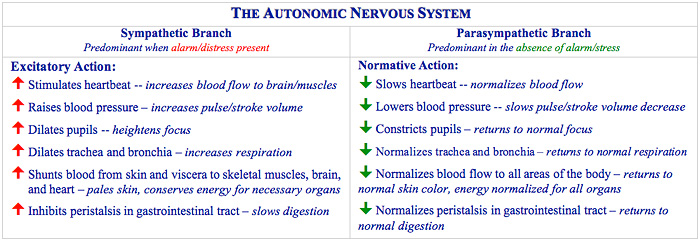Walter Cannon was an American Physiologist (Harvard) whose early research with x-rays with cats led him to the serendipitous discovery of the impact emotional distress can have on the physiological responses of cats. While investigating peristaltic action (the rippling motion of muscles used in the digestive process) in cats, Cannon observed that digestive action ceased whenever a cat showed any sign of alarm or distress. He further observed that as soon as a cat was consoled, the peristaltic action would return to normal. This accidental discovery led Cannon to investigate the effects of emotional responses on a broad range of organs and systems in the body. As his work progressed, he determined that one general combination of automatic actions and visible behaviors would occur in states of alarm and another general combination would occur when the emotional alarm or distress dissipated and was replaced with calm. Cannon referred to the alarm state condition as fight or flight. Later, others would characterize the normative state as rest and digest. Cannon’s findings led him to publish Bodily Changes in pain, hunger, fear and rage in 1915, in which he first used the phrase fight or flight to explain the excitatory response observed in a state of alarm.
Cannon came to realize that the autonomic nervous system was not only responsible for managing the emotionally triggered behaviors he had observed in his work, but also for managing the automatic routines needed to regulate the body’s vital functions. Building on Bernard’s earlier principle of milieu interieur (internal environment), Cannon introduced the concept of homeostasis in 1929 to describe the process of maintaining inner constancy. By Cannon’s definition, homeostasis was not a chance occurrence, but the result of organized management of the body by the autonomic nervous system in the face of changing external or internal conditions. (Cannon, The Wisdom of the Body, 1932, pp. 299-300) Cannon’s work helped to explain how a body, made of extraordinarily unstable material, could maintain a constant internal temperature, regulate blood sugar levels, fight off disease, cool itself with sweat and more to maintain homeostasis. In 1932, Cannon shared his findings and explained the important role played by the autonomic system in maintaining homeostasis in his book, The Wisdom of the Mind. (B. Cannon, Walter Bradford Cannon: Reflections on the Man and his Contributions, International Journal of Stress Management, Vol. 1, No. 2, 1994 pp.145-156).
While Langley had earlier provided the basic structural understanding of the autonomic nervous system, it was Walter Cannon who gave it real meaning. Some of the many regulatory differences that Cannon’s work uncovered are highlighted in the following table:
